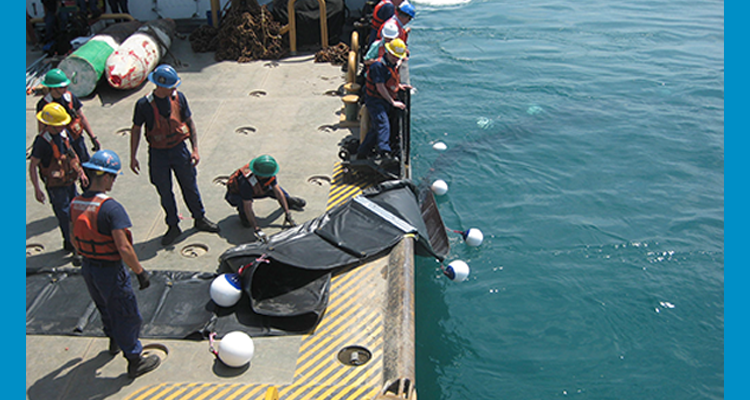June 15, 2018 —

Coast Guard personnel deploy an underwater barrier from Coast Guard Cutter Hollyhock into Lake Huron during testing May 29-31, 2018, as part of a Research and Development Center oil spill mitigation project. The 200-foot barrier is designed to collect moving sunken oil. U.S. Coast Guard photo.
PORT HURON, Michigan – The Coast Guard Research and Development Center was on Lake Huron the week of May 29, 2018, to test an underwater barrier system designed to mitigate the impacts of moving sunken oil in offshore environments and large lakes.
This barrier system is one of three prototypes the RDC plans to develop with industry to address the challenges faced when responding to sunken oil that migrates along the bottom of a water body. The objective for this prototype is to collect moving sunken oil in an open, sandy bottom, low-current environment.
RDC deployed the barrier from Coast Guard Cutter Hollyhock and enlisted the help of divers to affix the barrier to the lake bottom. RDC deployed the barrier in two locations; each time the test team gathered lessons on how well it was set out and retrieved. RDC also monitored the performance of the barrier during the time it was fixed to the lake bottom using a video camera attached to a remotely operated vehicle.
Although no oil was used, the week-long test provided an opportunity for RDC to deploy the barrier, monitor its effectiveness, and retrieve it. Representatives from Coast Guard Headquarters, a local U.S. Environmental Protection Agency representative, and two regional directors from the office of Sen. Gary Peters, D-Mich., observed portions of the test.
With funding support from the Environmental Protection Agency through the Great Lakes Restoration Initiative, RDC is undertaking efforts to improve overall spill response capabilities for non-floating oil because of the increasing transport of oil sands and diluted bitumen (dilbit) in the Great Lakes region. Depending on environmental conditions and the type of oil spilled, oil can sink to the bottom of inland water bodies and travel with the current. Sunken oil can cause significant detrimental impacts to the surrounding environment and local economy as evidenced by the 2010 dilbit spill in the Kalamazoo River. Few research and development efforts are focused on this particularly challenging issue in the oil spill response field.
RDC tested the first prototype in April, on the Kalamazoo River; the barrier was specifically designed for sunken oil spill response in inland water bodies such as rivers, streams or small lakes. The primary objective of that barrier test was to deflect moving sunken oil into a quieter part of the river for easier collection or prevent it from reaching sensitive areas.
RDC plans to test the third prototype on the Kalamazoo River, in April 2019. RDC will consolidate results and lessons learned from all three tests into a single comprehensive report.
For more information: Research, Development, Test and Evaluation program page